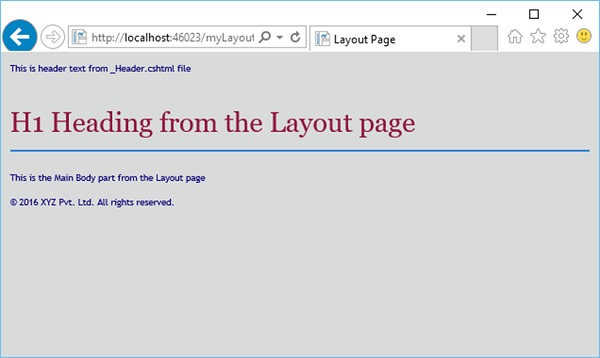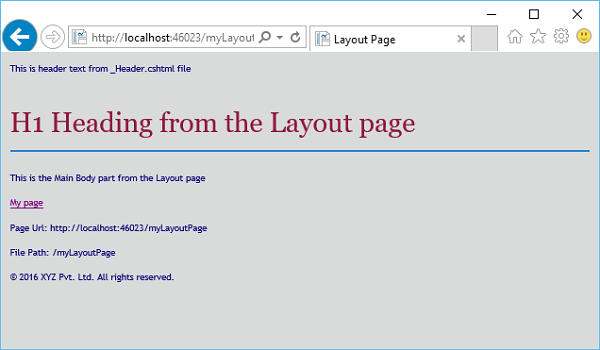- ASP.NET WP-全局页面
- ASP.NET WP-全局页面(1)
- asp.net 模型 - C# (1)
- asp.net 模型 - C# 代码示例
- ASP.NET WP-使用文件
- ASP.NET WP-使用文件(1)
- ASP.NET WP-数据库(1)
- ASP.NET WP-数据库
- ASP.NET WP教程(1)
- ASP.NET WP教程
- 讨论ASP.NET WP(1)
- 讨论ASP.NET WP
- ASP.NET WP-概述
- ASP.NET WP-缓存(1)
- ASP.NET WP-缓存
- ASP.NET WP-发布
- ASP.NET WP-发布(1)
- ASP.NET WP-布局(1)
- ASP.NET WP-布局
- ASP.NET WP-图表
- ASP.NET WP-图表(1)
- ASP.NET WP-使用视频
- ASP.NET WP-使用视频(1)
- ASP.NET WP-添加搜索
- ASP.NET WP-添加搜索(1)
- ASP.NET WP-入门
- ASP.NET WP-入门(1)
- ASP.NET WP-环境设置
- ASP.NET WP-环境设置(1)
📅 最后修改于: 2020-11-21 05:29:48 🧑 作者: Mango
ASP.NET中最基本的对象是页面。您可以直接访问页面对象的属性,而无需任何限定对象。在前面的章节中,我们使用了诸如Layout,RenderPage和RenderBody之类的页面对象的某些属性和方法。 WebPageBase类是表示ASP.NET Razor页面的类的基类。
页面对象模型的属性和方法
以下是页面对象的一些最常用的属性。
| S.No | Property & Description |
|---|---|
| 1 |
IsPost Returns true if the HTTP data transfer method used by the client is a POST request. |
| 2 |
Layout Gets or sets the path of a layout page. |
| 3 |
Output Gets the current TextWriter object for the page. |
| 4 |
Page Provides property-like access to data shared between pages and layout pages |
| 5 |
Request Gets the HttpRequest object for the current HTTP request. |
| 6 |
Server Gets the HttpServerUtility object that provides web-page processing methods. |
以下是页面对象的一些最常用的方法。
| S.No | Method & Description |
|---|---|
| 1 |
ConfigurePage When overridden in a derived class, configures the current web page based on the configuration of the parent web page. |
| 2 |
DefineSection Called by content pages to create named content sections. |
| 3 |
ExecutePageHierarchy() Executes the code in a set of dependent web pages. |
| 4 |
GetOutputWriter Returns the text writer instance that is used to render the page. |
| 5 |
href Builds a URL using the specified parameters |
| 6 |
InitializePage Initializes the current page. |
| 7 |
IsSectionDefined Returns a value that indicates whether the specified section is defined in the page. |
| 8 |
PopContext Returns and removes the context from the top of the OutputStack instance. |
| 9 |
PushContext Inserts the specified context at the top of the OutputStack instance. |
| 10 |
RenderBody() Renders the portion of a content page that is not within a named section (In layout pages) |
| 11 |
RenderPage(page) Renders the content of one page within another page |
| 12 |
RenderSection(section) Renders the content of a named section (In layout pages) |
| 13 |
Write(object) Writes the object as an HTML-encoded string |
| 14 |
WriteLiteral Writes an object without HTML-encoding it first. |
让我们看一下页面对象的页面属性的简单示例,该示例提供对页面和布局页面之间共享的数据的类属性访问。在此示例中,我们将使用Page.Title属性设置页面的标题。
这是MyLayoutPage.cshtml文件的实现,我们在其中设置了页面标题。
@{
Layout = "~/_Layout.cshtml";
page.Title = "Layout Page";
}
H1 Heading from the Layout page
This is the Main Body part from the Layout page
现在,我们需要在_Layout.cshtml页面中指定相同的页面标题,如以下代码所示。
@{ }
@Page.Title
@RenderPage("/Shared/_Header.cshtml")
@RenderBody()
@RenderPage("/Shared/_Footer.cshtml")
让我们运行该应用程序并指定以下URL- http:// localhost:46023 / MyLayoutPage,然后您将看到以下页面。

如您所见,标题现在是一个布局页面,我们已经使用Page对象的Page属性设置了该页面。
让我们看一下另一个简单的示例,其中我们将使用Page对象的Request属性
@{
Layout = "~/_Layout.cshtml";
Page.Title = "Layout Page";
var path = Request.FilePath;
var pageUrl = this.Request.Url;
}
H1 Heading from the Layout page
This is the Main Body part from the Layout page
My page
Page Url: @pageUrl
File Path: @path
您可以使用页面的Request对象获取页面的文件路径和URL。让我们再次运行您的应用程序,您将看到以下输出。
